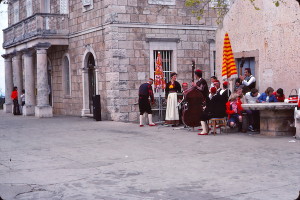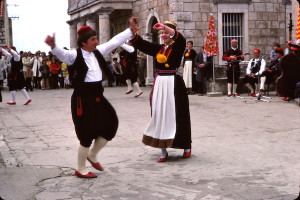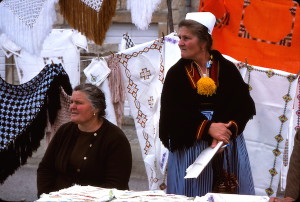Over a period of decades, I have made three side trips, from Dubrovnik, to the village of Cilipi in Croatia.
In 1976, I was one of a handful of press accompanying the American Society of Travel Agents (ASTA) to a meeting held in Dubrovnik. Some of the agents and press participated in a sightseeing program offered by our Yugoslavian hosts.
This included time in Cilipi, where locals, in traditional dress, played musical instruments, presented a dance program and lined up behind small tables to sell locally made souvenirs.
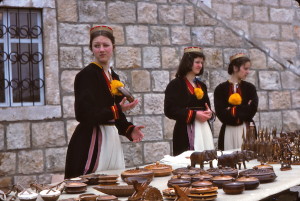
Young Cilipi women in traditional clothes for their region of the then Yugoslavia offer pottery and other goods for sale.
After the initial demonstration of folk dances, the entertainers invited visitors were invited to join the fun, and I have photos of me, in a business suit, dancing with one of our hosts.
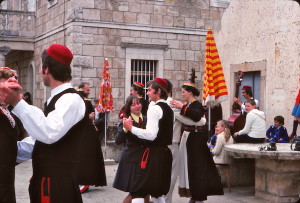
And, after the official program has concluded, visitors dance in the square, too, including the author, seen at center in a gray business suit.
It was a typical staged performance for visiting foreign tourists.
The second visit, in 1993, occurred after Croatia’s 1991-1992 war for independence from the former Yugoslavia, at a time when there were no tourists.
I was among a group of trade and consumer press on a trip sponsored by the Rebuild Dubrovnik Fund, a project initiated by ASTA, and Dubrovnik-based Atlas Travel. The industry was playing a part in helping rebuild a UNESCO heritage site as well as the tourism business on which so many depended. Press were there to describe the situation for travel agents and prospective travelers. We were joined by BBC newscaster Martin Bell, who had been covering the fighting in Bosnia.
Dubrovnik suffered damage, but area villages — easier to attack — were devastated.
At Cilipi, 60% of homes were uninhabitable. Except for the church and one house, all buildings on the town square were gutted, and only 400 of 1,000 residents were living there.
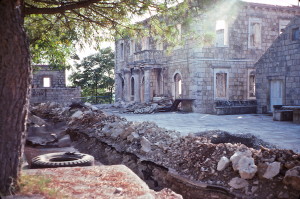
The Cilipi buildings, which could be seen in the background when we watched dancers perform in 1976, as they appeared in 1993. The ditch that had been dug across the central square is visible in the foreground.
No doubt, it would have looked even worse if the buildings hadn’t been made of stone, but it was a sad scene. The only consolation was stumbling upon a group of young volunteers, mostly from Australia and New Zealand, who had come at their own expense to work for a month in this town. They were digging a trench right across the square to restore a drainage system, and they seemed dedicated to their project.
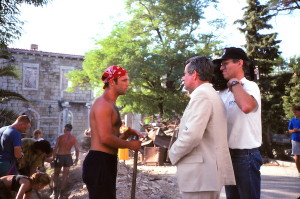
BBC newscaster Martin Bell (center) interviews one of the volunteers assisting with recovery at Cilipi in 1993.
In spring 2016, I accepted an assignment from Travel Weekly, the travel trade newspaper, to check out the new Viking Sea (part of the Viking Ocean Cruises’ growing fleet) on its inaugural sailing from Istanbul to Venice. This included a port call at Dubrovnik, and I leapt at the chance to revisit Cilipi, which appeared on one of the optional excursions.
However, the visit wasn’t what I had envisioned. The village was one of three on an itinerary called Flavors and Traditions of Old Croatia, and, as it turned out, all the action was centered on rural family businesses. None of the three village centers were part of the plan — although I asked for the chance to take a third set of photos at the heart of Cilipi where the buildings are whole again and pristine.
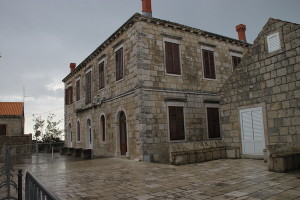
The same Cilipi buildings, now restored, seen on a rainy April afternoon in 2016. The pillars at the front entrance of the building at center, and visible in the top photo here, were not saved.
It seems that my 1976 and 2016 experiences, with a lot of years in between, inadvertently illustrated evolving tourist interests in more meaningful contacts with the cultures and people visited while on holiday.
Our Viking Sea group watched an olive grower demonstrate old ways of pressing olives, using a horse-powered mill and, second, a manually operated press. We had quite a discussion, too, about the meaning of cold press and extra virgin olive oil. He said extra virgin oil is to be preferred because contains no or very little amino acid.
At the second stop, we watched old ways of milling grain and fulling wool, both dependent on a fast-moving river and waterwheels. A young host outlined how his forebears used water and a watermill to make wool fabric waterproof. It seems counterintuitive to be using water, but it works when the fabric is made by combining sheep’s wool with some goat hair, which is oilier.
The Cilipi piece of this was lunch in a home, an authorized agribusiness, where much of the ground floor is set aside to host tour groups. Two folk singers entertained. We had brief tours of family gardens, the source of fresh foods served to visitors.
During the day’s sightseeing, we had options to buy our hosts’ products — olive oil and other foodstuffs. As a result, some participants literally carried tastes of Croatia home in their luggage.
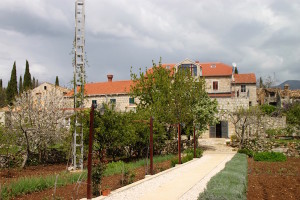
The Novakovic family farmhouse in Cilipi where passengers on the Viking Sea were hosted to lunch on an April day. The garden is seen in the foreground.

Millstones, at right, and a manually operated olive press, at left, set up as a display for visiting tourists at the Novakovic family farmhouse in Cilipi. The equipment is the same as that demonstrated early in the sightseeing itinerary for Viking Sea passengers. For the first, cold press of olives, the millstones would be pulled by a horse. The press at left would have been used with hot water to tease still more oil out of the olives.
For more about Croatia, we offer at BestTripChoices.com the following, under the headline: A young old country https://besttripchoices.com/international-countries/croatia/
This blog and photos (except one with the author in it) are by Nadine Godwin, BestTripChoices.com editorial director and contributor to the trade newspaper, Travel Weekly. She also is the author of “Travia: The Ultimate Book of Travel Trivia.”

